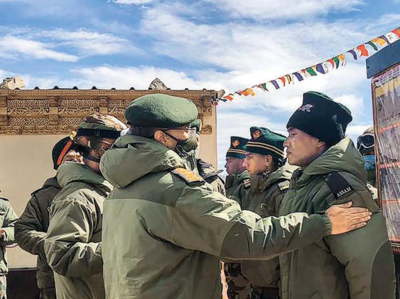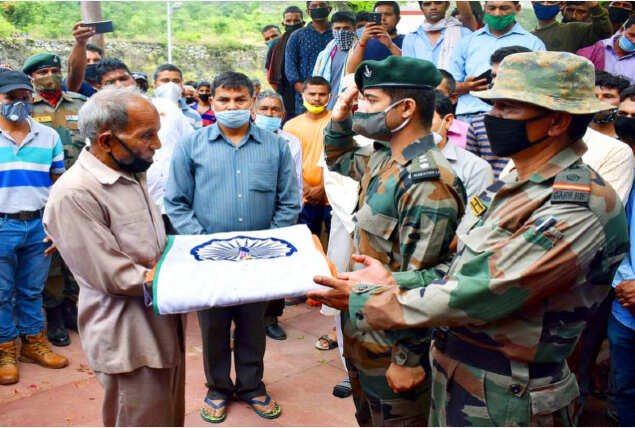Top Searches
- News
- India News
- Satellite images, reports indicate PLA’s set up camp at clash site
Satellite images, reports indicate PLA’s set up camp at clash site

Army chief Gen M M Naravane interacts with troops during his visit to forward areas in eastern Ladakh to review the situation (PTI)
NEW DELHI: Latest commercial satellite images and ground reports indicate Chinese troops are back on Indian territory in the Galwan Valley region in eastern Ladakh, setting up a much larger camp with gun positions in place of the observation post that was destroyed by Indian troops in the bloody clash of June 15.
The situation in several other sectors in eastern Ladakh remains very tense, with China reinforcing military positions in the Depsang Plains, while continuing to occupy Indian territory on the north bank of Pangong Tso.
With the People’s Liberation Army (PLA) seemingly determined not to withdraw any time soon, despite the two sides broadly agreeing on Monday to gradually disengage from the troop confrontations, Army chief General M M Naravane visited forward areas in eastern Ladakh to take stock of the operational situation on Wednesday. The satellite images on Wednesday showed that Chinese troops have come back in larger numbers to the “Patrolling Point-14 (PP-14)” area in the Galwan Valley region, the site of the brutal skirmish on June 15.
PLA opens new front with heavy troop build-up in Depsang Bulge
This time, PLA appears to have set up a large camp with gun positions at the site near the “Y-junction” of the Shyok and Galwan rivers, which is slightly over a kilometre below PP-14, a reference point that marks the Indian side of the Line of Actual Control (LAC).
Though there was no direct corroboration of the satellite images from the defence ministry or the Army, sources did confirm the fresh developments and said that there “is a huge trust deficit with the PLA” now.

Indian forces have “matched” PLA’s additional deployments of troops, artillery guns and armoured vehicles in the Depsang-Daulat Beg Oldie, Galwan, Hot Springs, Pangong Tso, Chushul, Demchok and Chumar sectors that stretch from north to south along the LAC in eastern Ladakh.
Gen Naravane reviewed the situation with Northern Command chief Lt-General Y K Joshi and 14 Corps commander Lt-General Harinder Singh, while also undertaking an aerial reconnaissance of the forward sectors in eastern Ladakh.
“We hope that the gradual and verifiable disengagement, as was decided in the June 22 meeting between Lt-Gen Singh and South Xinjiang Military District chief Major General Liu Lin, will begin soon. But we are prepared for the worst,” said a senior officer.
“The additional build-up by China has taken place between the June 15 clash and the June 22 corps commander-level talks,” said an officer. The situation is “serious” with the rival troops maintaining “stand-off distances” that vary from just a few meters to a couple of km in different sectors. “But there has been no violence since June 15,” he added.
PLA has also virtually opened up a new front in the Depsang Bulge area, a table-top plateau to the north of Galwan, with a huge deployment of troops and heavy weapons there to threaten the Burtse camp and Raki Nala areas of India. “But our forces are present there in adequate strength to prevent any misadventure,” said another officer.
Depsang is the same area which had seen a major 21-day face-off in April-May 2013 after PLA troops intruded 19km into Indian territory. The area is strategically important since it just about 30-35 km south of the strategic Karakoram Pass, which in turn is at the trijunction of the China-Pakistan-India borders and overlooks the Siachen Glacier-Saltoro Ridge to the west and the Indian observation post in the Chumar sector in the east.
The Depsang Bulge is the only staging area in the region, a large open land between high ridges of the Karakoram range in the north and Ladakh range in the south, from where Indian forces can group men and heavy weaponry to launch any action.
The situation in several other sectors in eastern Ladakh remains very tense, with China reinforcing military positions in the Depsang Plains, while continuing to occupy Indian territory on the north bank of Pangong Tso.
With the People’s Liberation Army (PLA) seemingly determined not to withdraw any time soon, despite the two sides broadly agreeing on Monday to gradually disengage from the troop confrontations, Army chief General M M Naravane visited forward areas in eastern Ladakh to take stock of the operational situation on Wednesday. The satellite images on Wednesday showed that Chinese troops have come back in larger numbers to the “Patrolling Point-14 (PP-14)” area in the Galwan Valley region, the site of the brutal skirmish on June 15.
PLA opens new front with heavy troop build-up in Depsang Bulge
This time, PLA appears to have set up a large camp with gun positions at the site near the “Y-junction” of the Shyok and Galwan rivers, which is slightly over a kilometre below PP-14, a reference point that marks the Indian side of the Line of Actual Control (LAC).
Though there was no direct corroboration of the satellite images from the defence ministry or the Army, sources did confirm the fresh developments and said that there “is a huge trust deficit with the PLA” now.

Indian forces have “matched” PLA’s additional deployments of troops, artillery guns and armoured vehicles in the Depsang-Daulat Beg Oldie, Galwan, Hot Springs, Pangong Tso, Chushul, Demchok and Chumar sectors that stretch from north to south along the LAC in eastern Ladakh.
Gen Naravane reviewed the situation with Northern Command chief Lt-General Y K Joshi and 14 Corps commander Lt-General Harinder Singh, while also undertaking an aerial reconnaissance of the forward sectors in eastern Ladakh.
“We hope that the gradual and verifiable disengagement, as was decided in the June 22 meeting between Lt-Gen Singh and South Xinjiang Military District chief Major General Liu Lin, will begin soon. But we are prepared for the worst,” said a senior officer.
“The additional build-up by China has taken place between the June 15 clash and the June 22 corps commander-level talks,” said an officer. The situation is “serious” with the rival troops maintaining “stand-off distances” that vary from just a few meters to a couple of km in different sectors. “But there has been no violence since June 15,” he added.
PLA has also virtually opened up a new front in the Depsang Bulge area, a table-top plateau to the north of Galwan, with a huge deployment of troops and heavy weapons there to threaten the Burtse camp and Raki Nala areas of India. “But our forces are present there in adequate strength to prevent any misadventure,” said another officer.
Depsang is the same area which had seen a major 21-day face-off in April-May 2013 after PLA troops intruded 19km into Indian territory. The area is strategically important since it just about 30-35 km south of the strategic Karakoram Pass, which in turn is at the trijunction of the China-Pakistan-India borders and overlooks the Siachen Glacier-Saltoro Ridge to the west and the Indian observation post in the Chumar sector in the east.
The Depsang Bulge is the only staging area in the region, a large open land between high ridges of the Karakoram range in the north and Ladakh range in the south, from where Indian forces can group men and heavy weaponry to launch any action.
FacebookTwitterLinkedinMail
Start a Conversation
end of article
Trending Topics
Quick Links
Coronavirus in MumbaiCoronavirus in KolkataCoronavirus in HyderabadCoronavirus in DelhiCoronavirus in BangaloreCoronavirus symptomsCoronavirus in IndiaWhat is CoronavirusCoronavirus NewsSolar EclipseNPRWhat is NRCCAB BillCAB and NRCRTI BillPodcast newsLok SabhaShiv SenaYSRCPCongressBJP newsUIDAIIndian ArmyISRO newsSupreme Court